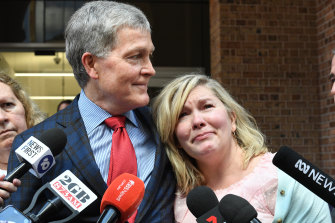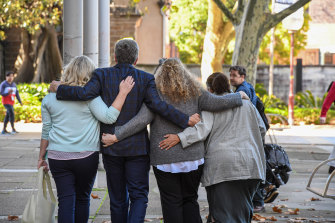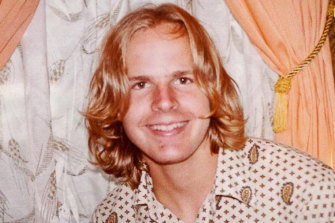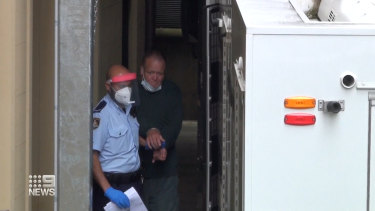Why Scott Johnson’s brother fears more killers of gay men may not be brought to justice
If not for Steve Johnson’s 15-year private investigation into his brother’s 1988 death, which did not always endear him to police, NSW would not be about to embark on the judicial inquiry announced last month into many potential gay-hate murders.
Justice Helen Wilson was unable to conclude – to the standard of evidence required by criminal law – that Scott Johnson’s murder was motivated by hatred of gays. However, the Supreme Court judge did accept the evidence of Helen White, former wife of Johnson’s killer, Scott White, that he had bragged to her about bashing gay men and that when she challenged him about Johnson’s death, he had told her: “The only good poofter is a dead poofter.”

Steve Johnson and sister Rebecca outside the court on Tuesday
.Credit:Peter Rae
It was a coroner’s finding in 2005 that two and probably three gay men were killed on the cliffs around a Bondi-Tamarama park in the 1980s that motivated Steve Johnson, an American IT entrepreneur, to ask: did the same thing happen to his brother, the 27-year-old mathematician and PhD student whose naked body was found at the base of a 60-metre cliff at North Head near Manly on December 10, 1988?
Police dismissed Scott Johnson’s death as a suicide on that first day, a conclusion soon confirmed by a coroner. Steve Johnson’s self-funded investigation led to a second inquest in 2012 – which threw out the suicide finding but left the cause of death open – and to a third inquest in 2017 which found Scott was pushed, hounded or frightened off the cliff.
This finding spurred the “fresh eyes” police investigation that led to Scott White, the man who has confessed to killing Scott Johnson more than three decades later, although White now claims he is innocent and is seeking an appeal against his own guilty plea.
As Steve Johnson reiterated to The Sydney Morning Herald on Tuesday, when White was sentenced to a maximum of 12 years and seven months in prison for the murder, his campaign was not only about finding justice for his brother but also for the many other gay murder victims.

Scott Johnson’s family leaving the court for the final time after the sentence was handed down.
It was a coroner’s finding in 2005 that two and probably three gay men were killed on the cliffs around a Bondi-Tamarama park in the 1980s that motivated Steve Johnson, an American IT entrepreneur, to ask: did the same thing happen to his brother, the 27-year-old mathematician and PhD student whose naked body was found at the base of a 60-metre cliff at North Head near Manly on December 10, 1988?
Police dismissed Scott Johnson’s death as a suicide on that first day, a conclusion soon confirmed by a coroner. Steve Johnson’s self-funded investigation led to a second inquest in 2012 – which threw out the suicide finding but left the cause of death open – and to a third inquest in 2017 which found Scott was pushed, hounded or frightened off the cliff.
This finding spurred the “fresh eyes” police investigation that led to Scott White, the man who has confessed to killing Scott Johnson more than three decades later, although White now claims he is innocent and is seeking an appeal against his own guilty plea.
As Steve Johnson reiterated to The Sydney Morning Herald on Tuesday, when White was sentenced to a maximum of 12 years and seven months in prison for the murder, his campaign was not only about finding justice for his brother but also for the many other gay murder victims.

Scott Johnson’s family leaving the court for the final time after the sentence was handed down.
Credit: Peter Rae
Among the experts he recruited to help him in that campaign was Sue Thompson, a former police gay liaison consultant. It was Thompson and Stephen Tomsen, a professor of criminology, who compiled a list of 88 deaths they regarded as potential gay-hate killings that will be considered by a special commission of inquiry led by Justice John Sackar, following recommendations by a lengthy NSW upper house inquiry.
Sackar’s task is to consider the unsolved cases among those 88, between 1970 and 2010. His load will be vastly reduced if he is to follow the statistical findings of NSW Police’s Strike Force Parrabell, which was formed following the public outcry that arose from Johnson’s campaign.
Of the 86 cases Parrabell reviewed (two were not in NSW), it found 63 had already been solved. Twenty-three remained unsolved. Of all 86, it found solid evidence of a “bias crime” – a gay-hate killing – in just eight cases, although it found a further 19 were “suspected bias crimes”. That is, police believed 27 people were probably killed because they were gay. Scott Johnson was among Parrabell’s suspected bias crimes.
Parrabell found no evidence of a gay-hate killing in 34 cases. And it found insufficient information to make a determination in 25 cases.
Among the experts he recruited to help him in that campaign was Sue Thompson, a former police gay liaison consultant. It was Thompson and Stephen Tomsen, a professor of criminology, who compiled a list of 88 deaths they regarded as potential gay-hate killings that will be considered by a special commission of inquiry led by Justice John Sackar, following recommendations by a lengthy NSW upper house inquiry.
Sackar’s task is to consider the unsolved cases among those 88, between 1970 and 2010. His load will be vastly reduced if he is to follow the statistical findings of NSW Police’s Strike Force Parrabell, which was formed following the public outcry that arose from Johnson’s campaign.
Of the 86 cases Parrabell reviewed (two were not in NSW), it found 63 had already been solved. Twenty-three remained unsolved. Of all 86, it found solid evidence of a “bias crime” – a gay-hate killing – in just eight cases, although it found a further 19 were “suspected bias crimes”. That is, police believed 27 people were probably killed because they were gay. Scott Johnson was among Parrabell’s suspected bias crimes.
Parrabell found no evidence of a gay-hate killing in 34 cases. And it found insufficient information to make a determination in 25 cases.

US mathematician Scott Johnson’s death was initially declared a suicide.
Of the 23 deaths that remained unsolved, it found solid evidence of a gay-hate crime in not a single case. It did find that five of the 23 were “suspected” bias crimes. Other than Johnson, they also included Ross Warren and John Russell, about whom the former deputy state coroner Jacqueline Milledge made a more definitive judgment in 2005; she found both were murdered in 1989 around the Bondi-Tamarama cliff walk. Russell’s body was found at the base of a cliff; Warren’s was never found.
Importantly, when delivering the Parrabell report in 2018, Assistant Commissioner Tony Crandell acknowledged it was possible that many in the “insufficient information” category might well have been gay-hate crimes. That category includes the 1986 death of William Rooney in a Wollongong lane. While it was written off as a drunken fall, some local detectives believed Rooney was murdered by a man who was jailed for assaults on 12 other men, most of them gay, who he bashed with a rock and raped. Parrabell concludes the coronial finding on Rooney was likely incorrect, but it could find insufficient evidence to elevate it from “insufficient information” to “suspected bias crime”.
Parrabell also found insufficient information in the case of Giles Mattaini, a Frenchman who disappeared while walking along the Bondi-Tamarama cliffs around Marks Park, a gay beat, in 1985. Milledge left the cause of his death open, but she said there was a strong possibility that Mattaini met a similar fate to Warren and Russell.
Parrabell had three years to review the 86 cases. Sackar has a little over a year to report.

Scott Phillip White pleaded guilty to the murder of Scott Johnson but is now appealing against his own plea.
Sue Thompson says the problem lies in NSW police adopting the FBI’s methodology for identifying bias crimes, which she says was designed for collating statistics on the likes of terrorists and white supremacists. She argues it is not fit for the purpose of police – when starting with insufficient evidence – keeping an open mind on the possibility that a death may have been a gay-hate-related crime. Thompson says the FBI criteria is “far too narrow, not suited to open-minded police investigation but geared to excluding cases using strict evidentiary standards for national uniform crime reports to Congress. That is foolish and wrong for policing.”
She points out that the Australian Institute of Criminology assessed 44 cases she had collated over just 10 years from 1989 to 1999 and found at least 37 could be confidently considered as possible gay-hate crimes.
“Using the FBI methodology,” Thompson says, “Scott Johnson’s case would never have been called a bias crime, or even reported as such.”
Steve Johnson has the same apprehension. He stressed on Tuesday that Wilson had treated the case with fairness and had restored Scott’s dignity. He had no complaint about her inability to identify the murder as a gay-hate killing.
But for more than a decade, he confronted a police force that resisted murder as the likely explanation for Scott’s death. Only after the third coroner found it was indeed a crime motivated by gay hatred did then-police commissioner Mick Fuller assign Detective Chief Inspector Peter Yeomans’ team to the “fresh eyes” investigation, which soon arrested Scott White.
“It was those fresh eyes that made the difference,” Steve Johnson told the Herald. “I hope this special commission of inquiry can consider the many neglected cases in that spirit.”
Johnson was hugely grateful for the “fairness” with which the case had been handled by Wilson, and outside court on Tuesday, he elaborated: “I sat in court today hoping the spirit of my brother will inspire this commission of inquiry ... I think bringing Scott White to justice should bring hope to the other families, but it’s also an example to the commission that these 30-year-old cases can still be solved and that it matters to bring perpetrators to justice after this length of time. We’re not so old yet that we can’t feel peace and relief.”
No comments:
Post a Comment